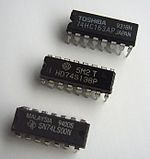Standard TTL[edit]
The 7400 series of transistor-transistor logic chips, developed by Texas Instruments in the 1960s, popularized the use of integrated circuits in computer logic. The military-grade version of this was the 5400 series.[33]
Microprocessor[edit]
Texas Instruments invented the hand-held calculator (a prototype called "Cal Tech") in 1967 and the single-chip microcomputer in 1971, was assigned the first patent on a single-chip microprocessor (invented by Gary Boone) on September 4, 1973.[34] This was disputed by Gilbert Hyatt, formerly of the Micro Computer Company, in August 1990, when he was awarded a patent superseding TI's. This was overturned on June 19, 1996, in favor of TI[35] (note: Intel is usually given credit with Texas Instruments for the almost-simultaneous invention of the microprocessor).
First speech synthesis chip[edit]
In 1978, Texas Instruments introduced the first single-chip linear predictive coding speech synthesizer.[36] In 1976, TI began a feasibility study of memory-intensive applications for bubble memory then being developed. They soon focused on speech applications. This resulted in the development the TMC0280 one-chip linear predictive coding speech synthesizer, which was the first time a single silicon chip had electronically replicated the human voice.[37][38] This was used in several TI commercial products beginning with Speak & Spell, which was introduced at the Summer Consumer Electronics Show in June 1978. In 2001, TI left the speech synthesis business, selling it to Sensory Inc. of Santa Clara, California.[39]
Consumer electronics and computers[edit]
In May 1954, Texas Instruments designed and built a prototype of the world's first transistor radio, and, through a partnership with Industrial Development Engineering Associates of Indianapolis, Indiana, the 100% solid-state radio was sold to the public beginning in October of that year.[40]
In the 1960s, company president Pat Haggerty had a team that included Jack Kilby to work on a handheld calculator project. Kilby and two other colleagues created the Cal-Tech, a three-pound battery-powered calculator that could do basic math and fit six-digit numbers on its display. This 4.25 x 6.15 x 1.75 inch calculator's processor would originate the vast majority of Texas Instruments' revenue.[20]
In 1973, the handheld calculator SR-10 (named after slide rule) and in 1974, the handheld scientific calculator SR-50 were issued by TI. Both had red LED-segments numeric displays. The optical design of the SR-50 is somewhat similar to the HP-35 edited by Hewlett-Packard before in early 1972, but buttons for the operations "+", "–", ... are in the right of the number block and the decimal point lies between two neighboring digits.
TI continued to be active in the consumer electronics market through the 1970s and 1980s. Early on, this also included two digital clock models - one for desk and the other a bedside alarm. From this sprang what became the Time Products Division, which made LED watches. Though these LED watches enjoyed early commercial success due to excellent quality, it was short-lived due to poor battery life. LEDs were replaced with LCD watches for a short time, but these could not compete because of styling issues, excessive makes and models, and price points. The watches were manufactured in Dallas and then Lubbock, Texas. Several spin-offs of the Speak & Spell, such as the Speak & Read and Speak & Math, were introduced soon thereafter.[41]
In 1979, TI entered the home computer market with the TI-99/4, a competitor to such entries as the Apple II, TRS-80, and the later Atari 400/800 series and VIC-20. It discontinued the TI-99/4A (1981), the sequel to the 99/4, in late 1983 amid an intense price war waged primarily against Commodore. At the 1983 Winter CES, TI showed models 99/2 and the Compact Computer 40 (CC-40), the latter aimed at professional users. The TI Professional (1983) ultimately joined the ranks of the many unsuccessful DOS and x86-based—but non-compatible[42]—competitors to the IBM PC (the founders of Compaq, an early leader in PC compatibles, all came from TI). The company for years successfully made and sold PC-compatible laptops before withdrawing from the market and selling its product line to Acer in 1998.[43]
You received this message because you are subscribed to the Google Groups "1TopReadys1" group.
To unsubscribe from this group and stop receiving emails from it, send an email to 1topreadys1+unsubscribe@googlegroups.com.
To view this discussion on the web visit https://groups.google.com/d/msgid/1topreadys1/CAForgrSBj8iBMk%3DtGUcrfn3br1OZCuyos8YMnsCBoO9daz8ZdA%40mail.gmail.com.



No comments:
Post a Comment